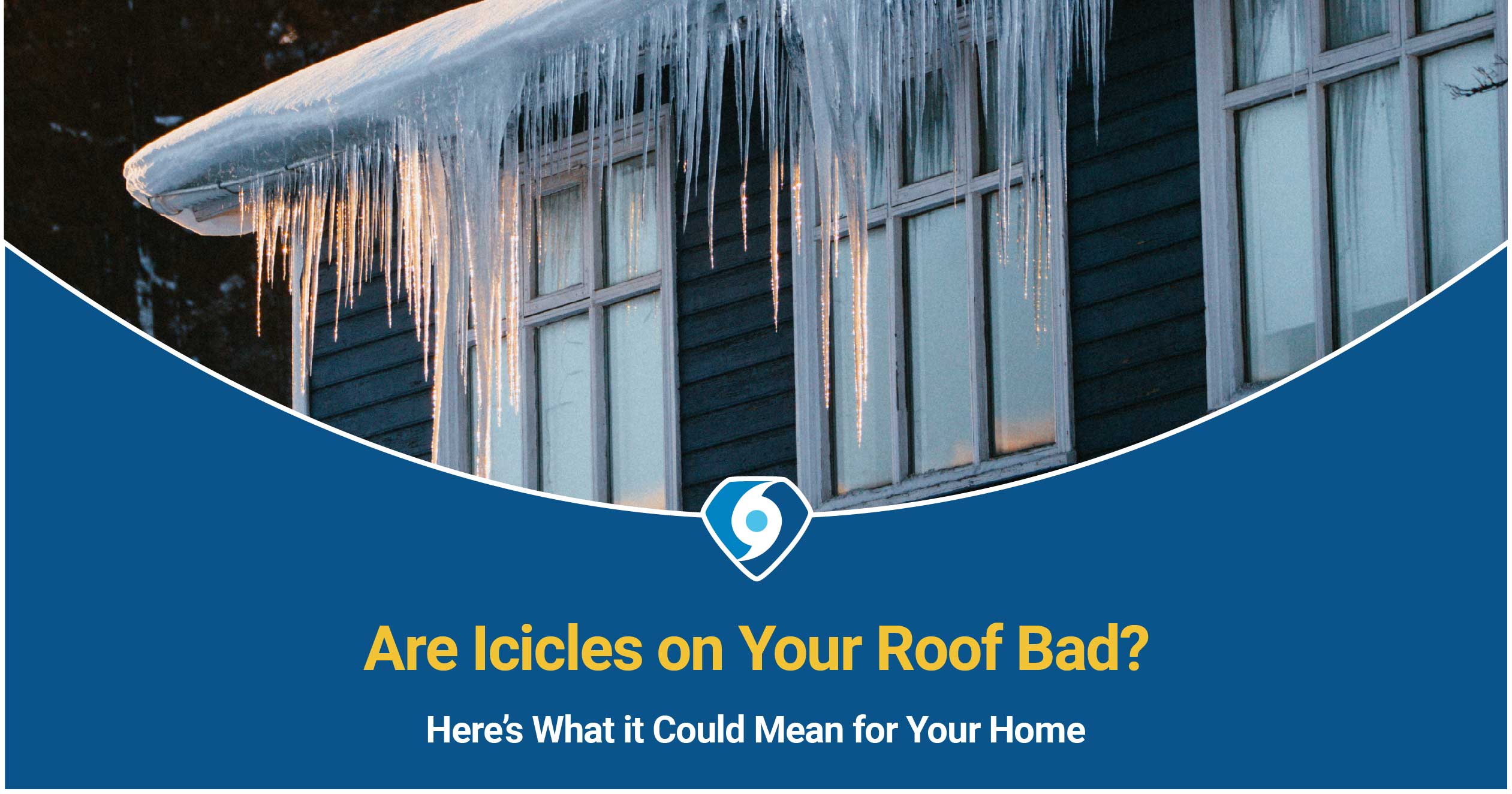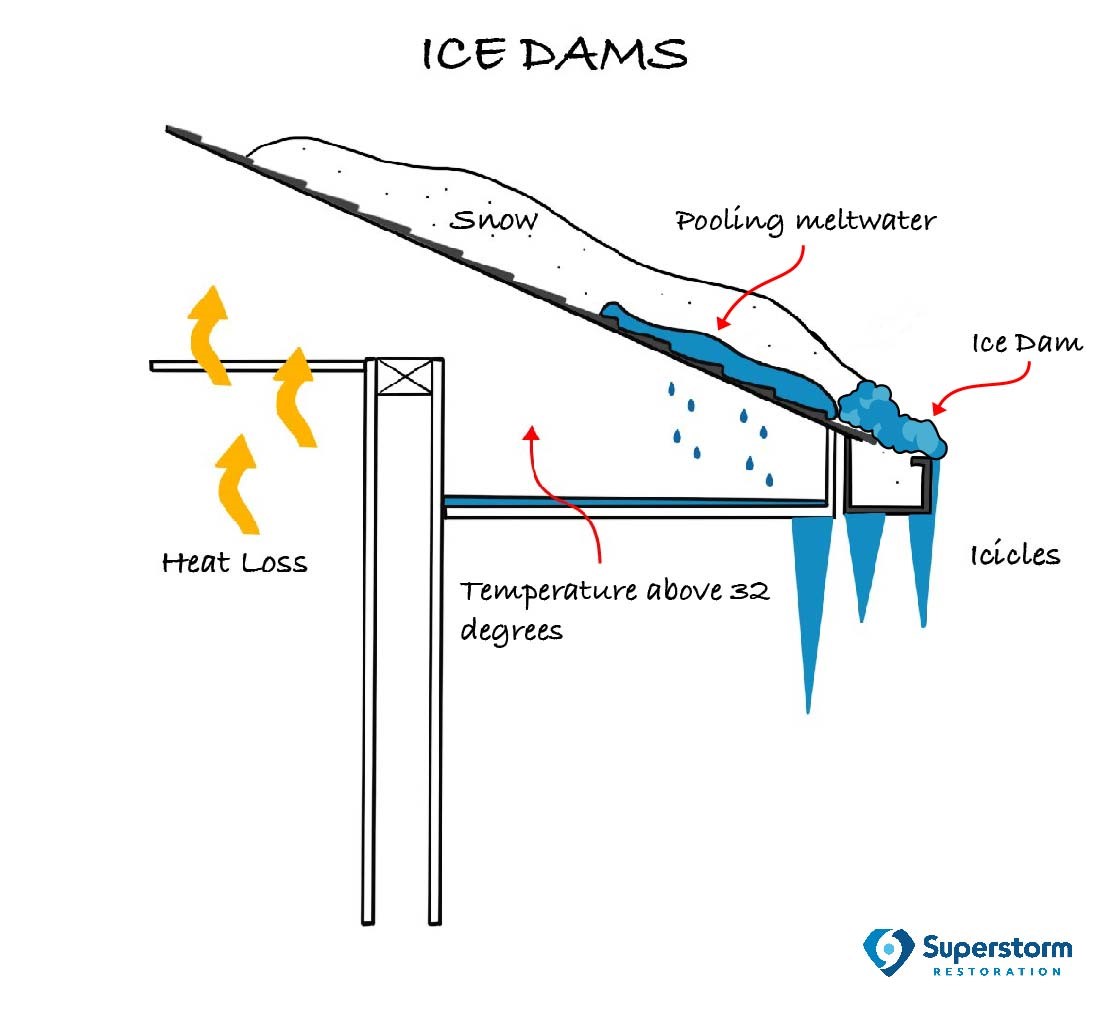
How to Remove & Prevent Ice Dams
When you imagine a winter wonderland, you probably picture fluffy snow in the yard, smoke piping out the chimney, and beautiful icicles dripping down the tip of the roof. While icicles along the roofline may seem like a picture-perfect scene, it could be a signal that trouble is near. The same conditions that produce icicles can create ice dams, which can cause significant damage to a home. Read on to discover how to prevent ice dams before they lead to expensive roof repairs.
What Is An Ice Dam?
An ice dam is a thick structure of ice that has built up over time along the eaves of a roof. This is caused by a cycle of melting and freezing water conditions throughout the winter.
What Causes Ice Dams?
Ice dams form after heavy snowfall on the roof. When the roof warms up from heat inside the attic, it causes the snow to melt and sends running meltwater down the roof. This will freeze once it gets to the edge of the roof, forming a pile of ice. This process will continue to form larger ice dams and can even cause significant damage to the home.

How Ice Dams Form On a Roof
- Heat from the attic warms parts of the roof while other sections stay cold. Heat naturally rises, which can make the attic a toasty place during the winter. The attic is supposed to be the same temperature as the outdoors. If your roof isn’t properly sealed, the insulation needs to be replaced, or the attic isn’t properly vented, that warmth will stay and cause a temperature imbalance on your roof.
- The warm roof causes snow to melt, but it freezes again on the cold eaves. The problem occurs because the heat is not equally distributed, and the eaves of your roof are colder than the rest of your roof. The water will flow down the roof until it reaches the freezing temperatures on the eaves where it will freeze and accumulate into an ice dam.
- Excess meltwater will collect above the ice dam. The ice dam will continue to grow from the melting water supply until the water no longer reaches the freezing point of the roof and starts to accumulate.
- Water & ice dams cause roof damage. The backed-up water will eventually find cracks in the shingles and seep through the roof. This is how ice dams cause roof leaks and other damage to the home. As the cycle of melting and freezing occurs, water will find its way into the cracks, expand, and cause permanent damage.
Will Ice Dams Damage My Roof?
Yes, there are many ways ice dams can cause roof damage and other issues to your home. The types of damage which homeowners will notice quickly include:
- Roof leaks
- Lose shingles
- Torn off or damaged gutters
However, there are many other damages caused by ice dams that you may not notice until some time passes. The signs that you’ve had roof damage or water backed up in the past include:
- Stained or sagging ceilings
- Peeling paint
- Warped floors
- Soggy insulation
Along with these physical damages to the property, there are a couple of other red flags homeowners may start to observe when they have damage caused by ice dams. First, you will probably notice your heating bill keeps going up. Since the roof is releasing its warmth due to poor insulation or leaks, you’ll eventually start paying more to maintain the same amount of heat in your home. Second, you might run into unwanted pests in your home. Insects, mice, and other critters can sneak inside through small cracks, even the size of a small roof leak, and many of them are looking for a dark and damp place to inhabit. If you have standing water caused by an ice dam, that is exactly the type of environment these pests will seek out and thrive in.
How to Fix Ice Dams
If you already have an ice dam on your roof and are looking to get rid of it before major damage occurs, these can be great solutions. We encourage homeowners to be cautious and consider their safety when performing any of these tasks to not cause further roof damage or injuries. Additionally, our roofing experts want to reiterate that these tips and tricks will combat the current problem at hand, but if you’re looking for more long-term solutions that prevent future damage, continue to read the section below this.
- Using a rake to safely remove excess snow or ice. This will release any water that may have built up underneath and change the temperature on the roof’s exterior. It is important to note that homeowners should not try to remove ice dams with shovels or other sharp tools. This would be a dangerous task and will cause more damage to the roof. It may rip off or chip your shingles, allowing more water to get into the structure causing you to need a new roof or worse, more evasive repairs. Additionally, if there are already chips and cracks in the roofing, melted water could settle into these cracks and freeze and expand, resulting in further damage.
- Create a path to release excess water. Using ice melt or a heated cable, you can clear a trail between ice structures for the excess water to break through to the gutters. Before attempting this, it is important to check that the gutters are clear and can drain the meltwater properly.
- Freeze existing leaks to prevent further damage. If you’re experiencing roof leaks because the ice dam has already started harming the property, try to stop the water from running into your house and causing additional problems. We recommend doing this by temporarily turning down the temperature and aiming a fan at the source of a current leak. This will allow you to freeze the leak while you tackle one of the other approaches to remove the excess water, then patch the leak.
- Homeowners should avoid using any chemicals on the roof. Many ice-melt products combine salt and other chemicals that make the salt a more effective de-icing treatment. More targeted ice-melting chemicals are available but we do not recommend them for asphalt roofs. Unfortunately, some of these chemicals can harm asphalt shingles, especially if the chemicals are left on the roof for long periods, and their use may void the manufacturer's limited warranty.
How to Prevent Ice Dams
If you’re worried about how ice dams can cause roof leaks and other damage, start planning ahead so you won’t have to stress next winter season! The key to preventing ice dams on the roof is keeping the surface at a cold and consistent temperature to fend off melting snow. We’ve got a few options that will provide a long-term solution to get rid of ice dams on the roof.
- Add insulation in the attic. Regularly checking your insulation will help you know when it needs to be replaced or when you should increase the amount you currently have. According to most building codes, homes should have 12-14 inches of fiberglass or cellulose insulation.
- Increase roof ventilation. Additional ventilation will add a layer of protection that will draw in cold and flush out the warm attic air. Adding soffit vents and ventilation strips to the eaves will help your roof maintain a consistent, cool temperature. Learn more about roof ventilation.
- Remove heat sources from the attic. During the winter, try to keep your traffic and heat upstairs in the attic to a minimum. This includes turning off lights or other heat sources if applicable and keeping doors closed to try to keep the space cool and avoid paying to heat the space with your furnace system.
- Seal all air leaks. As we’ve mentioned, air leaks are the culprit for easily losing heat through the roof and can cause other issues along with ice dams. Homeowners can check for air leaks in these common places:
- Gaps in drywall
- Cracks around windows and light fixtures
- Openings around the chimney
- Space between the roof and plumbing pipes, access hatches and other ceiling openings
- Use Owens Corning ice & water barriers. If you’ve previously experienced roof leaks, hiring a professional to install an additional layer of protection could save you from further roof damage from ice dams. These special barriers are self-sealing and apply an additional layer of waterproofing to your roof.
If you’ve read (or skipped) this far, it can be very overwhelming learning all the potential damage that can occur to a roof. By taking action today, you could be saving yourself a lot of hassle and money because most roofing contractors won’t provide warranty work if the underlying cause is improper attic insulation and ventilation.
Call Superstorm for Help With Your Roof
Ice dams should be removed by professionals in your area as they can fix the issues as well as address underlying causes and prevent future damage. If you’re unsure whether you need to take action or get the ice removed, send us a couple of photos by filling out the contact form or call us at 515-225-4880. Our local roofing contractor team will review and be in contact with you with the best ice dam prevention and maintenance.
Superstorm provides free inspections and evaluations so that the customers we serve are educated on their options.